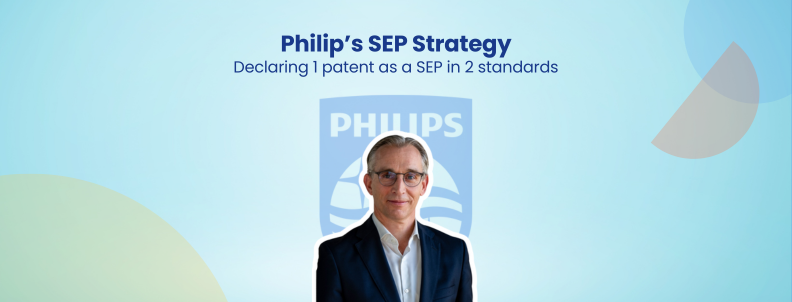Generally, patents are filed with a particular standard in mind. Take, for instance, a scenario where researchers filed a patent related to a concept in 5G technology. The typical route for obtaining returns from such a patent would involve declaring it essential to 5G within the 3GPP organization.
But have you ever wondered what the returns would be if the same could be declared as a SEP in Wi-Fi6 as well?
Philips has been using this strategy to dominate the game and get double the ROI from their SEP patents! Since this strategy is one of a kind, this study will dive in a little deeper to uncover how you can shape your IP strategy to double the ROI.
Decoding Philips’s high ROI IP Strategy?
In a recent project, one of our clients (an IP counsel at a telecom giant) discussed reviewing the patents declared to Sisvel’s Wi-Fi6 patent pool. The aim was to identify patents from their portfolio that can be potential Wi-Fi SEP and submit them to the pool. During this review, the client also asked to identify if some companies have declared their patents to both Wi-Fi6 and 5G to perform a similar analysis for his patent set as well.
That is where we identified that Philips is one such company that has declared certain patents to both Wi-Fi and 4G/5G. Philips has declared certain patents to the Wi-Fi6 Sisvel Patent Pool (see CN102823177 declared to 802.11ax or Wi-Fi6 standard snapshot below).
Source: Sisvel Wi-Fi6 patent list Aug, 2023
Without spending additional money or cost, Philips also declared the same patents to ETSI (4G/5G SEP). For example, CN102823177A is declared to ETSI_TS 36.213.
| Patent | Title | Status | Patent Owner | Declared ETSI Spec |
| CN102823177A | A method for operating a secondary station | Granted | KONINKLIJKE PHILIPS ELECTRONICS NV | ETSI_TS 36.213 |
Out of 1041 patents listed in the pool, Philips was the only one with patents declared for Wi-Fi and 4G.
Fill out the form below to get the complete list of Philips patents declared for Wi-Fi6 and 4G. See which similar patents in your portfolio will become standards in the Wi-Fi6 and 4G/5G spheres for double returns.
FORM
Increasing the value of your patent portfolio with this strategy
Philip’s IP strategy appears to be simple at first glance. However, the primary challenge lies in identifying concepts that can be applied to multiple standards. This requires a thorough analysis of patents in the context of various technologies.
By doing so, you can develop a comprehensive understanding of the IP landscape and identify opportunities to leverage existing patents or develop new ones in collaboration with the R&D team.
Let’s take an example of LDPC, a concept common to Wi-Fi and 5G. WiFi has been using LDPC codes for error correction for many years. Later, 5G’s new radio adopted the codes for cellular communication. Although there are some differences, the similarities between the concepts make this technology suitable for both standards, as shown below.
| Concept | Snapshot from Wi-Fi standard documentation (IEEE 802.11 2020) | Snapshot from 5G standard documentation (3GPP TS 38.212 V15.13.0) |
| LDPC Coding | Section 19.3.11.7.4 of IEEE Std. 802.11 2020 | 3GPP TS 38.212 V15.13.0 |
Therefore, realizing the possibility that a concept applicable to one standard will start getting used in another standard helps generate double revenue from one SEP.
Conclusion
The catch in this whole strategy is identifying cross-standard concepts. This involves understanding multiple standards and their underlying principles and finding ways to leverage them. While the process is comprehensive and complex, the ultimate benefit is clear: increased returns, improved utilization of intellectual property, and a stronger competitive position.
Double the licensing money from the same patent set without much effort.
Authored by: Rohit Sood and Swapnajeet Nayak, Infringement Team
Edited by: Annie Sharma, Editorial team











